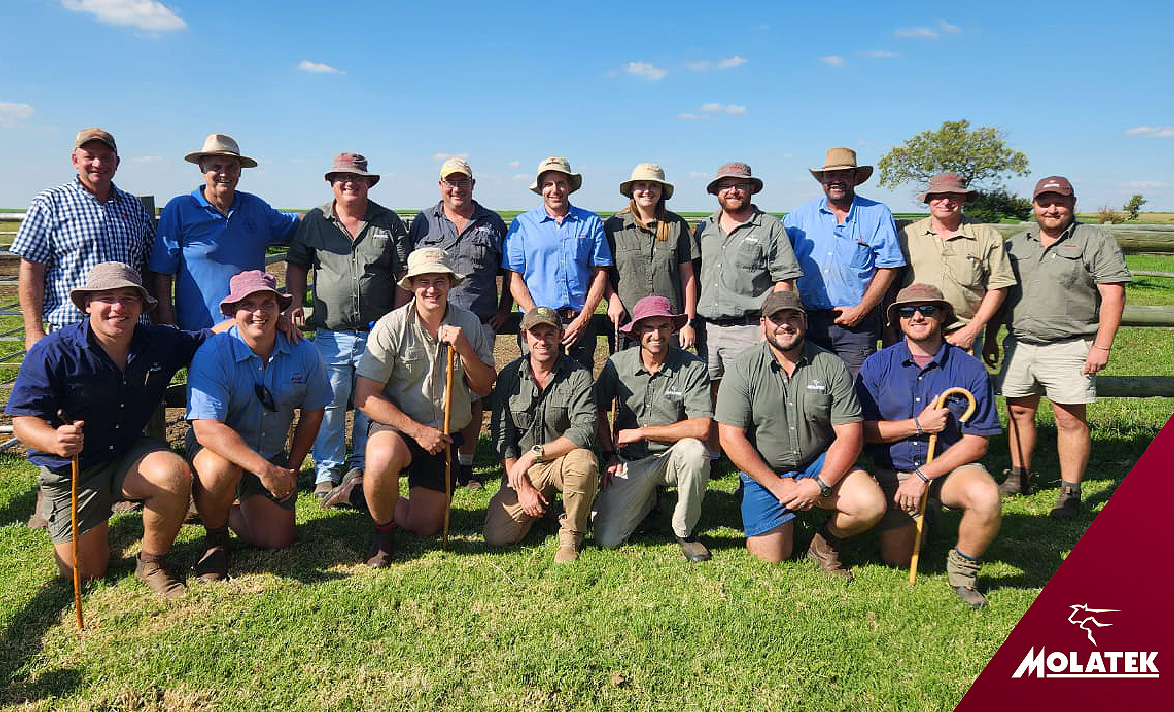AGE OF HEIFERS AT FIRST CALVING INFLUENCES LIFETIME PRODUCTIVITY
Dr Vlok Ferreira, Technical Executive, Molatek
In beef cattle, cow productivity can be measured as kg per calf weaned per large stock unit mated. (KgC/LSU). Implementing an effective replacement heifer program may be a big challenge for beef cattle farmers and is a challenge that needs to be addressed.
The first topic to discuss is how to ensure that heifers reach sexual maturity at the right age, and what effects it will have on productivity, as well as factors that influence it. The age at which heifers become sexually mature is very important when accounting for productivity, as we want them to calf as close to 2 years of age as possible.
Age at which puberty is reached:
Age, weight, and breed all have an impact on the age at which a heifer will reach puberty.
Age: The goal of many producers is to have heifers calf for the first time at 2 years of age. For this to happen, the heifer should reach puberty at 12 – 15 months of age. This will also depend on the breed of the cow. European breeds reach puberty at the age of 12 months, where breeds in South Africa generally reach puberty at the age of 14 – 15 months.
Weight: Weight is the factor that most influences puberty, and a heifer will reach puberty when she weighs 65-70% of her potential mature weight.
Breed: Larger, late maturing breeds will reach puberty at a later stage than early maturing breeds and will generally have a calving age of 27 months rather than 24 months. The average weight will differ for each breed.
Heifer breeding weight because of breed
| Breed | Mature Weight | Minimum Weight |
| Bonsmara | 492 kg | 320 kg |
| Beefmaster | 498 kg | 324 kg |
| Brangus | 465 kg | 302 kg |
| Simbra | 534 kg | 347 kg |
| Charolais | 590 kg | 383 kg |
| Nguni | 365 kg | 237 kg |
| Santa Getrudis | 489 kg | 318 kg |
Age at first heat:
Heifers need to have an average daily gain of 800g/day from weaning to first service or have a total gain of 115-160 kg during the first winter in approximately 200 days.
For most breeds this means that the cross-breed heifers need to weigh between 295 and 385 kg.
Age of 1st heat cycle (%) on 2 levels of weight gain
| 360 g/day gain | 12 months old | 13 months old | 14 months old | 15 months old |
| Angus | 0 | 0 | 33 | 82 |
| Hereford | 11 | 22 | 33 | 38 |
| Crossbreed | 0 | 12 | 68 | 85 |
| 730 g/day gain | 12 months old | 13 months old | 14 months old | 15 months old |
| Angus | 30 | 58 | 100 | 100 |
| Hereford | 12 | 50 | 100 | 100 |
| Crossbreed | 18 | 76 | 94 | 94 |
The above tables indicate the ages from 12 to 15 months, the average daily gain, and the resulting percentage of heifers from Angus breed, Hereford breed, and the Angus-Hereford cross-breed progeny that reached their first heat cycle. It is important to note that crossbreeds will reach maturity at an earlier age than either of the parent breeds.
The conclusion that we can draw from these two tables is that heifers who have a greater daily gain will reach maturity at a younger age than heifers who do not have a sufficient daily gain.
Age at 1st calving:
Heifers that calve at the age of 2 years and then calves every following year, will produce 330 kg more weaned calf weight than if they calved for the first time at 3 years of age over a lifetime basis.
The main conclusion that we can draw from the above discussion is that heifers should reach an optimal weight to reach puberty in a timely manner, but that breed effects will have a large influence in what this weight should be. Crossbreeds are optimal in this case as they reach puberty faster than parental breeds.
The Heritable traits that can influence cow productivity:
- Weaning weight of the calf
- Feed requirements of the cow-calf combination (per LSU- Large Stock Unit)
- The rate at which calves are born (indicated by means of inter-calving period – ICP)
How to calculate Calving percentage and Cow Productivity:
Calf % = 100 – ((Inter-calf Period – 365 days)/365 X 100)
Example:
Inter-calf period: 420 days
Calf % = 100 – ((420 – 365)/365 X 100)
= 84.9%
Cow productivity = (Weaning % X weaning weight at 205 days)/LSU [we assume that the calving percentage is equal to the weaning percentage]
Example:
Weaning weight at 205 days: 210 kg
Cow productivity = 0.849 X 210/1.45 LSU
=123 kg
Easing the shock of weaning:
Removing the calf from its mother is a necessary procedure, but also one that unfortunately lowers the productivity of the calf. For the first 14 days after weaning, the calf will likely experience a drop in body weight due to stress and lack of eating if the weaning process is not properly managed.
Creep feed or at least a production lick/supplement is important to ease the weaning shock. Creep feed is a way of introducing feed to the calf whilst it is still suckling. Getting used to eat out of a feed trough before being weaned is one way to ensure that body weight is maintained during the weaning process, as the calf will already be used to eating feed.
Conclusion:
The results emphasise the importance of focusing on fertility and identifying the reasons for low calving percentage, such as age at first calving; body condition score (BCS) and lick supplementation practices.
Should you have any questions or concerns regarding how to properly feed your bull herd during the winter months or preparing them for an auction, contact your Molatek Technical Advisor.


